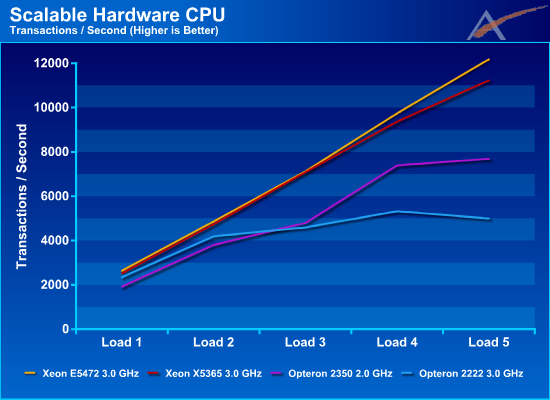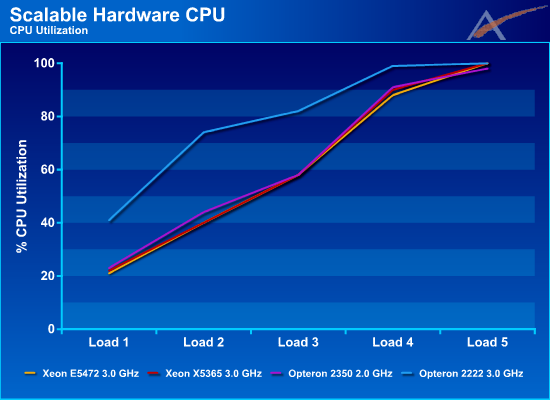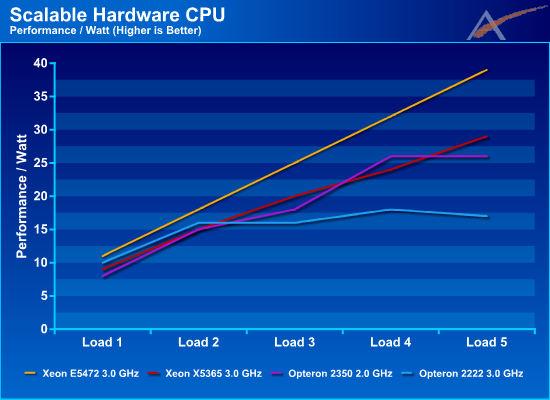Intel "Harpertown" Xeon vs. AMD "Barcelona" Opteron
by Jason Clark & Ross Whitehead on September 18, 2007 5:00 PM EST- Posted in
- IT Computing
Scalable CPU

Unlike the AS3AP benchmark where AMD is able to lead at the lower load points, Intel is able to dominate this benchmark. Again we see the improvements which Harpertown brings over Clovertown. The Xeon E5472 is able to lead the Opteron 2350 by as much as 59%. We also see that the quad-core 2350 does provide much more headroom than its dual-core 2222 sibling.

All quad-core systems exhibit similar CPU utilization with the dual-core Opteron ramping significantly quicker.

The Harpertown system is much more competitive on this benchmark with regards to power consumption. In fact, all quad-core parts are within 4-8% of each other.

With Intel's better performance and much closer power consumption on this benchmark, Harpertown is the clear leader for all load points. The Xeon E5472 is able to lead by as much as 46% over the Opteron 2350. Barcelona is competitive with Clovertown, but it has a long way to go to match Harpertown

Unlike the AS3AP benchmark where AMD is able to lead at the lower load points, Intel is able to dominate this benchmark. Again we see the improvements which Harpertown brings over Clovertown. The Xeon E5472 is able to lead the Opteron 2350 by as much as 59%. We also see that the quad-core 2350 does provide much more headroom than its dual-core 2222 sibling.

All quad-core systems exhibit similar CPU utilization with the dual-core Opteron ramping significantly quicker.

The Harpertown system is much more competitive on this benchmark with regards to power consumption. In fact, all quad-core parts are within 4-8% of each other.

With Intel's better performance and much closer power consumption on this benchmark, Harpertown is the clear leader for all load points. The Xeon E5472 is able to lead by as much as 46% over the Opteron 2350. Barcelona is competitive with Clovertown, but it has a long way to go to match Harpertown










77 Comments
View All Comments
Hans Maulwurf - Thursday, September 20, 2007 - link
Barcelona is about as fast as Harpertown in AS3AP. OK.In your article you write:
"The Scalable Hardware benchmark measures relational database systems. This benchmark is a subset of the AS3AP benchmark and tests the following: ..."
Now you choose a subset of this test in which Harpertown is much faster. Obviously AS3AP consist of several substest and you could as well choose one where Barcelona is much faster. But whats the use of this? You tested all subtest together with your AS3AP-Test.
Its the same as testing a game and both CPUs having the same score. Then you choose a subtest(e.g. KI only) where Harpertown is faster and conclude its faster overall.
So what did I miss here? From what I read Barcelona is as fast in AS3AP as Harpi(and should be faster in some subtest and slower in others) while you conclude:
"Intel has made some successful changes to the quad-core Xeon that have helped it achieve as much as a 56% lead in performance over the 2.0GHz Barcelona part."
I dont understand this.
tshen83 - Thursday, September 20, 2007 - link
Did anyone here notice the huge metal bar across the FB-DIMM slots? It must be for more FB-Dimm cooling. Without looking at the server first hand, you can't tell how the metal bar is attached to the memory.My question is this: where can you buy the bar if you were to build a server class PC yourself? And can someone tell me the mounting mechanism.
Viditor - Thursday, September 20, 2007 - link
One other piece of data is missing from the article, and it's looking like it might be important...
Kris Kubicki wrote in his blog
"The 2.0 GHz samples we saw on Monday were of AMD's B1 stepping of Barcelona. But these processors are not the ones we'll see on Newegg's shelves"
"Production Barcelona samples come with the BA revision designator"
"One AMD developer, who wished to remain anonymous for non-disclosure purposes, stated, "B1 versus BA should be at least a 5%, if not more, gain in stream, integer and FPU performance.""
"An AMD engineer, when confronted with the claim, stated that 5% gains when moving from B1 to BA processors "seem conservative.""
Given that, when you guys do the update, could you let us know which stepping it is that you're using? It appears that it may make a significant difference...
JarredWalton - Thursday, September 20, 2007 - link
Remember: 5% performance gains in synthetic benchmarks that stress specific aspects of a CPU don't mean 5% real-world gains.Viditor - Thursday, September 20, 2007 - link
I agree...but that's exacly why I am looking forward to some real-world benches on the production steppings. We still have no idea how shipping Barcelonas perform yet.
Viditor - Thursday, September 20, 2007 - link
Further on that...supposedly the reason for the better performance is fixing some major errata. It's quite possible that the performance boost is across the board and not just in synthetic benches.Schugy - Wednesday, September 19, 2007 - link
You run two benchmarks, you run closed software, you run software that might be optimized for the market leader's processors only, you run software that can't be optimized for the new architecture, you don't benchmark any alpha software that uses rapid virtualization.Maybe we have some benchmark numbers but the real performance of Barcelona is still speculation.
clnee55 - Wednesday, September 19, 2007 - link
AMD is always the underdog. They need superior product to gain market share. That was the case of Athlon vs Netburst. If Barcelona is just competitive, it is not good enough for them to regain the crown. They will stay as underdog.randomname - Wednesday, September 19, 2007 - link
From what I understand, these new (Harpertown) Xeons will not be released until November (12th?). Yet the article makes no mention of it, and by reading it, you would assume you can buy them right now.Or have I understood something wrong?
mutambo - Wednesday, September 19, 2007 - link
Intel systems are power mongers...generate enough heat to replace a room heater.Check out any dual socket systems they are using all kinds of cooling to cool the FB-DIMMs those are the worst part in intel builds.